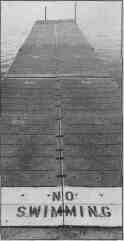
Photograph by Randy Squires |
Is it safe to go in? By Stu Jacobson |

Photograph by Randy Squires |
Is it safe to go in? By Stu Jacobson |
A year ago, the residents of Springfield learned it's risky to swim in their lake. That was after 97 triathletes contracted "swamp fever," the infection scientists call leptospirosis. The mysterious bacterial outbreak generated headlines throughout Illinois and across the country. But the general risks associated with swimming in any body of freshwater shouldn't have been news to residents of the Midwest, where lakes and streams are subject to contamination through suburban sprawl, soil siltation, wild and domestic animal wastes (the probable source of Lake Springfield's leptospirosis) and a veritable soup of manufactured chemicals.
The capital city's ban on lake recreation was lifted in time for this summer's fun, and boaters and swimmers have begun to return to that lake, and to other central Illinois lakes where health-related problems have bobbed briefly into public awareness. Still, the events of this past year should raise a few long-range concerns. How safe are the state's lakes, really? The short answer: Okay for drinking; no guarantees on swimming.
More fundamentally, how healthy is the ecology of Illinois' natural water system? This has a short answer too: The best measure of the health of any lake is its water quality.
The nature of watersheds and how they function helps explain this relationship. A watershed is the area that drains into a stream, river or lake. In urban and suburban environs this can include roads, yards and even roofs, anything that conveys runoff to storm sewers and eventually to streams or lakes. On a continental scale, the entire Mississippi River Basin serves as one watershed, stretching from eastern Montana to western Pennsylvania and points south. Most Illinois lakes, usually impoundments created by damming streams or rivers, have large watersheds because they're designed to provide drinking supplies for cities and towns. The trouble is the use of such basins is not curtailed in Illinois as is the case in many eastern states.
Virtually all activity in watersheds affects the chemistry, biology and to some degree the physical characteristics of lakes. The lakes throughout most of Illinois — especially those in our flat, bulging midsection dominated by corn and bean production — are affected significantly by agriculture. Insecticides, herbicides, silt and suspended solids, crop residues and animal wastes all enter the streams and eventually the lakes. Some suspended matter, as well as dissolved chemicals, flows over dams. But the slowing of currents as rivers enter lakes means much of the material stays in those lakes, while the cleaner water flows on downstream.
Yet each lake is affected differently. Lake Decatur, in the east central part of the state, has had significant problems with nitrates due to fertilizer runoff from farmland. Sediment buildup has been the top problem in Lake Peoria. And before there was leptospirosis in Springfield, there was atrazine. In 1994, routine water sampling in that city changed the way many people thought about the lake and its watershed. The results of tests conducted by the Illinois Environmental Protection Agency showed high contamination from atrazine, the most widely used herbicide for corn in the area.
Increasingly, these problems are being addressed by federal, state and county soil and crop advisers. And by farmers. Among the solutions: voluntary reduction of atrazine, no- spray setbacks and vegetative buffer strips that filter runoff from fields.
Greg Good, who monitors the quality of Illinois lakes for the state Environmental Protection Agency, bases his assessments on a number of considerations. But he says the larger the watershed in relation to a lake's surface, the lower the water quality. Decatur and Springfield, for example, have larger watersheds in relation to the sizes of their lakes. A second important factor is age. Older lakes have accumulated more silt, more nutrients, such as fertilizer, and more pollutants, including insecticides.
After examining data Good provides, it becomes clear that few Illinois lakes are comparable to those in Canada, or even Wisconsin. Those few are either glacial lakes near the Wisconsin border or lakes in the Shawnee National Forest in southern Illinois, where streams flow through pasture or woodlands.
Ivan Dozier adds another factor in assessing the quality of lakes in the vast central region of the state. Dozier is a Macoupin County-based conservationist with the U.S. Department of Agriculture, and he says the quality of a lake's water is affected by the time it takes that lake to flush itself of substances, especially dissolved substances like atrazine and nitrates. This could explain, for example, why atrazine has been more of a problem for Lake Springfield, with its longer retention time, than for Lake Decatur.
There are other factors, as well. Rapid development in communities surrounding Springfield likely has an adverse impact on the lake. That's also likely the case in rapid-growth communities surrounding Chicago. Runoff from roads and streets, from construction, from lawns and from faulty septic tanks all take their toll on water quality.
Fortunately, community water purification plants filter and chemically treat these insults to our lakes and streams, so the water is safe enough to drink. As for taking a dip? The truth is there's a limit on how much we can reduce the risk of contracting diseases. In short, you swim at your own risk in Illinois' lakes and streams.
Stu Jacobson is an adjunct professor of biology at the University of Illinois at Springfield.
24 / July/August 1999 Illinois Issues